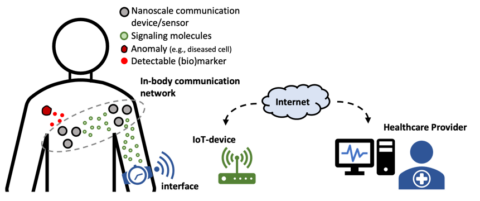Seminar on the Internet of BioNanoThings
While conventional communication systems rely on electromagnetic waves, Molecular Communication (MC) encodes information into the properties of small particles. This allows communication between nodes with sizes on the order of nanometers and micrometers, and in fluidic and biological environments where classical communication concepts are not applicable. Thus, engineered MC systems are expected to enable communication between nanomachines and facilitate interaction with biological systems. This will pave the way for several medical, agricultural, and industrial applications, including targeted drug delivery, environmental monitoring, nanoscale quality control, and communication in oil and gas pipelines.
One of the most fascinating envisioned applications of MC is the Internet of BioNanoThings (IoBNT), which is expected to have a strong influence on the development of digital health in society. So far, the Internet of Things (IoT) has marked an important step towards digitalization, as it enables the autonomous exchange of information between multiple devices. This advance has also triggered an earlier evolution of healthcare systems, such as the emergence of wearable and implantable health monitoring devices connected to the Internet. The next revolutionary but logical step to further advance personalized healthcare is to extend the IoT to the inside of the human body. This idea gave rise to the concept of IoBNT, which facilitates the detection and treatment of diseases inside the human body based on an in-body network of nanodevices and an external control unit (see Figure 1). The in-body network includes synthetic and biological sensors and actuators in the cardiovascular system to detect biomarkers and provide localized and personalized treatment. The technical feasibility of the IoBNT requires the deployment of an MC network inside the body, a gateway between the inner and outer networks, and appropriate communication protocols for sophisticated monitoring and control processes. For example, based on a nanosensor network deployed in the cardiovascular system, the IoBNT can sense vital signs and biomarkers to continuously monitor an individual’s health status and detect and predict abnormalities. The IoBNT also enables intelligent drug delivery with actuators that target diseased cells while minimizing drug waste and side effects.
In this seminar, we will cover the most important aspects of the emerging research field of MC and its application to the development of communication methods and architectures for IoBNT.
Topics
- Introduction to Molecular Communications (MC)
- Modelling and Simulation of MC Systems
- The Cardiovascular System as an MC System
- In-body MC Concepts
- Introduction to the Internet of Bio-NanoThings (IoBNT)
- Applications of the IoBNT
- Hardware for IoBNT Systems
- Gateways and Interfacing Concepts for the IoBNT
- Experimental MC and IoBNT Systems
For a registration for this seminar please visit the EEI department’s registration pages on StudOn (Sep. 23 – Oct. 6, 2024): https://www.studon.fau.de/xcos5919501.
For details contact
Dr.-Ing. Maximilian Schäfer
Department of Electrical-Electronic-Communication Engineering
Institute for Digital Communications (IDC) (Prof. Dr. Schober)
- Phone number: +49 9131 85-25017
- Email: max.schaefer@fau.de
